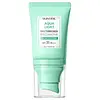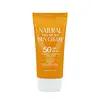What's inside
What's inside
 Key Ingredients
Key Ingredients

 Benefits
Benefits

 Concerns
Concerns

 Ingredients Side-by-side
Ingredients Side-by-side

Water
Skin ConditioningEthylhexyl Methoxycinnamate
UV AbsorberDimethicone
EmollientBis-Ethylhexyloxyphenol Methoxyphenyl Triazine
Skin ConditioningPhenylbenzimidazole Sulfonic Acid
UV AbsorberDiethylamino Hydroxybenzoyl Hexyl Benzoate
UV FilterCetearyl Olivate
Potassium Cetyl Phosphate
EmulsifyingTitanium Dioxide
Cosmetic ColorantCoco-Caprylate/Caprate
EmollientAllantoin
Skin ConditioningAluminum Starch Octenylsuccinate
AbsorbentTremella Fuciformis Sporocarp Extract
AntioxidantTriacontanyl Pvp
HumectantSqualane
EmollientHydroxyacetophenone
AntioxidantSorbitan Olivate
EmulsifyingCeramide AP
Skin Conditioning1,2-Hexanediol
Skin ConditioningUrea
BufferingEctoin
Skin ConditioningButylene Glycol
HumectantDimethicone/Vinyl Dimethicone Crosspolymer
Skin ConditioningBisabolol
MaskingTheobroma Cacao Seed Extract
AntioxidantLactobacillus/Soymilk Ferment Filtrate
Skin ConditioningAdansonia Digitata Seed Extract
Skin ConditioningSodium Carbomer
Emulsion StabilisingPolyhydroxystearic Acid
EmulsifyingCarbomer
Emulsion StabilisingSodium Hydroxide
BufferingAminomethyl Propanol
BufferingHydrated Silica
AbrasiveBHT
AntioxidantHydrogen Dimethicone
Aluminum Hydroxide
EmollientPentylene Glycol
Skin ConditioningWater, Ethylhexyl Methoxycinnamate, Dimethicone, Bis-Ethylhexyloxyphenol Methoxyphenyl Triazine, Phenylbenzimidazole Sulfonic Acid, Diethylamino Hydroxybenzoyl Hexyl Benzoate, Cetearyl Olivate, Potassium Cetyl Phosphate, Titanium Dioxide, Coco-Caprylate/Caprate, Allantoin, Aluminum Starch Octenylsuccinate, Tremella Fuciformis Sporocarp Extract, Triacontanyl Pvp, Squalane, Hydroxyacetophenone, Sorbitan Olivate, Ceramide AP, 1,2-Hexanediol, Urea, Ectoin, Butylene Glycol, Dimethicone/Vinyl Dimethicone Crosspolymer, Bisabolol, Theobroma Cacao Seed Extract, Lactobacillus/Soymilk Ferment Filtrate, Adansonia Digitata Seed Extract, Sodium Carbomer, Polyhydroxystearic Acid, Carbomer, Sodium Hydroxide, Aminomethyl Propanol, Hydrated Silica, BHT, Hydrogen Dimethicone, Aluminum Hydroxide, Pentylene Glycol
Water
Skin ConditioningCyclopentasiloxane
EmollientEthylhexyl Methoxycinnamate
UV AbsorberZinc Oxide
Cosmetic ColorantTitanium Dioxide
Cosmetic ColorantPEG-10 Dimethicone
Skin Conditioning4-Methylbenzylidene Camphor
UV AbsorberBeeswax
Emulsion StabilisingIsododecane
EmollientGlycerin
HumectantCyclohexasiloxane
EmollientSorbitan Sesquioleate
EmulsifyingMagnesium Sulfate
Tocopheryl Acetate
AntioxidantAluminum Hydroxide
EmollientStearic Acid
CleansingDisteardimonium Hectorite
StabilisingWater, Cyclopentasiloxane, Ethylhexyl Methoxycinnamate, Zinc Oxide, Titanium Dioxide, PEG-10 Dimethicone, 4-Methylbenzylidene Camphor, Beeswax, Isododecane, Glycerin, Cyclohexasiloxane, Sorbitan Sesquioleate, Magnesium Sulfate, Tocopheryl Acetate, Aluminum Hydroxide, Stearic Acid, Disteardimonium Hectorite
 Reviews
Reviews

Ingredients Explained
These ingredients are found in both products.
Ingredients higher up in an ingredient list are typically present in a larger amount.
Aluminum Hydroxide is a form of aluminum. It can be naturally found in nature as the mineral gibbsite. In cosmetics, Aluminum Hydroxide is used as a colorant, pH adjuster, and absorbent.
As a colorant, Aluminum Hydroxide may add opacity, or reduce the transparency. Aluminum hydroxide is contains both basic and acidic properties.
According to manufacturers, this ingredient is an emollient and humectant. This means it helps hydrate the skin.
In medicine, this ingredient is used to help relieve heartburn and help heal ulcers.
There is currently no credible scientific evidence linking aluminum hydroxide in cosmetics to increased cancer risk.
Major health organizations allow the use of aluminum hydroxide in personal care products and have not flagged it as a carcinogenic risk at typical usage levels.
Learn more about Aluminum HydroxideEthylhexyl Methoxycinnamate is an organic compound that provides UVB protection. It often goes by the more common name of octinoxate. It is created from methoxycinnamic acid and 2-ethylhexanol.
Ethylhexyl Methoxycinnamate absorbs UVB rays with wavelengths between 280-320 nm. UV absorbers protect your skin by using chemical reactions to convert UV rays into heat and energy.
UVB (290-320 nm) rays emit more energy than UVA rays. They are capable of damaging DNA, causing sunburns and are thought to be linked to skin cancer.
The state of Hawaii has banned sunscreens containing octinoxate due to its potential impact on coral reefs. More research is needed to bridge gaps in this research. The European Union allows higher levels of octinoxate in sunscreens than the US and Australia.
Ethylhexyl Methoxycinnamate is oil soluble. It is not stable and may lose efficacy when exposed to sunlight.
Learn more about Ethylhexyl MethoxycinnamateTitanium dioxide is a mineral UV filter widely used in sunscreens and cosmetics.
It is one of only two UV filters officially classified as “mineral” by regulatory agencies, the other being zinc oxide.
Titanium dioxide provides broad-spectrum protection mostly in the UVB and UVAII range, with some protection in the UVAI range.
While its UVA protection isn’t as strong as zinc oxide’s, the difference is minor.
A common myth is that mineral UV filters reflect UV light. However, modern research shows titanium dioxide absorbs UV radiation like chemical filters (~95% absorption & 5% reflection).
Thanks to its non-irritating nature, titanium dioxide is suitable for sensitive, acne-prone, or redness-prone skin. It is unlikely to cause "eye sting" like other sunscreen ingredients.
A major drawback of this ingredient is its white cast and thick texture. This is why mineral sunscreens often leave a white cast and are less cosmetically elegant than chemical/hybrid sunscreens.
To improve white cast and spreadability, micronized or nano-sized titanium dioxide is often used.
There are ongoing concerns surrounding nano-titanium oxide's impact on marine ecosystems.
There is no conclusive evidence that any form of titanium oxide (or any other sunscreen ingredients) will cause harm to marine ecosystems or coral reefs. The science is still developing but many consumers are keeping a close eye on this issue.
Please note, many destinations have reef-safety sunscreen rules. For instance, the U.S. Virgin Islands advises all visitors to use non-nano mineral sunscreens.
Nano mineral sunscreens once raised safety concerns about absorption into skin.
Extensive research has shown that they do not penetrate healthy or damaged skin; they remain safely on the surface and the top layer of dead skin (stratum corneum).
You'll likely find titanium dioxide bundled with alumina, silica, or dimethicone. These ingredients help make titanium dioxide highly photostable; this prevents it from interacting with other formula components under UV light.
Learn more about Titanium DioxideWater. It's the most common cosmetic ingredient of all. You'll usually see it at the top of ingredient lists, meaning that it makes up the largest part of the product.
So why is it so popular? Water most often acts as a solvent - this means that it helps dissolve other ingredients into the formulation.
You'll also recognize water as that liquid we all need to stay alive. If you see this, drink a glass of water. Stay hydrated!
Learn more about Water